|
|
|
 |
| |
Travel the World and the Seven Seas…
Scuba diving is experiencing a surge in popularity around the world, as more people look to get more out of their Beach holiday destinations by spending as much time below the waves as on the beach admiring them.
Absolute SCUBA opens doors to a fabulous world of diving with our customized trips to dream diving spots around the world. We plan these trips based on 15 years of Dive Industry know-how, dive travel experience and most importantly, client feedback.
Our trips are meticulously planned based on certification or diving requirements, group size, budgets and seasonal availability. We take pride in associating ourselves with only the best land-based or Liveaboard Operators both within India and outside.
All groups are escorted by our own Instructor to ensure liaison, continuity and consistency in quality.
We also assist independent dive travellers by providing well researched options at various destinations for both diving as well as accommodation and transfers.
|
| |
Goa : needs very little introduction to the World. The perennial beach destination is never far for most who treat Goa as a quick get-away to de-stress, laze in the sun, eat and explore its quaint streets, food and culture.
There exists another Goa too. And one that attracts visitors of a different kind… Divers !
All diving at Goa takes place at the Grande Island set; 3 small islands off the shore that have everything from vibrant fish life, stunning Plate & Whip Coral patches to Ship wrecks and more.
Diving in Goa can be challenging on account of less than perfect visibility but there’s much to be seen and learnt from that too. Resident Harbor Porpoises (Dolphins)are almost a daily sighting to & from dive sites.
Ideal for Introductions, Beginner and Advanced courses, Goa is an easy destination to get to and enjoy non-diving time too at the many other distractions this idyllic get-away offers. |
|
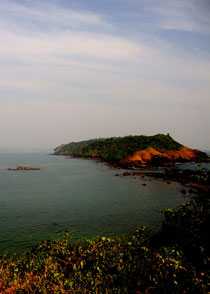 |
| Dive Centers are conveniently located and a range of accommodation is easily available to suit all requirements. Contact us to Dive Goa. |
|
|
Netrani Island officially known as Pigeon Island, Netrani has been a quiet, little secret hidden just 220 kilometers South of Goa. Netrani is a huge rock island, jutting out of the Blue, just 20 kilometers off-shore from Murudeshwar in North Karnataka.
Great visibility, healthy & vibrant coral, friendly Eels and everything from Giant Groupers to Lobsters abound at this amazing destination. We’ve had the awesome experience of snorkeling with Whale Sharks here ! And there’s a good chance to see Pilot Whales&Dolphins in the right season too.
Swim in crystal clear waters, dive through an amazing Grotto and round off your day with a visit to the largest Shiva statue & temple in the World at Murudeshwar.
In all our experience, Netrani is the closest one can get to superior diving, this side of the Lakshadweep Sea. |
|
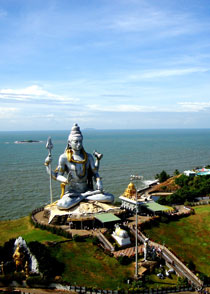 |
Overnight road access from Pune and easy road or train connectivity from Goa make this a great weekend destination for course completion or an easy 4 – 6 dives for certified divers who are itching to dive but just don’t have the time to manage a full-on dive holiday.
Netrani is ideal for seasoned divers&all levels of Certification courses. Amazingly inexpensive to reach & stay, Contact us for an amazing get-away to Netrani. And get lucky with Whale Sharks!! |
|
|
Andaman Islands need very little introduction. A must-visit destination for everyone, the Andamans’ assault the senses maddeningly. Rain-forests & mangroves, tropical beaches (some of the Best in Asia), a deluge of fascinating Flora & Fauna, lovely drives, Historic sites and amazing islands to visit in India’s only Marine National Park – these are some of the top-side charms of Amazing Andamans.
Underwater, these Volcanic-origin islands are another story. The Andaman Sea is a cauldron of fish life and coral, thrown together and thriving in a nutrient rich eco-system. Home to an astonishing number of species, diving in the Andamans is always exciting. Manta Rays, Reef Sharks, Groupers, Turtles, Eels and countless species of Coral make diving here an unforgettable experience.
Absolute Scuba brings you the opportunity to dive or travel to one or more islands including Wandoor, Chidiya-Tapu (South Andaman island), Havelock, Neil and even Barren (India’s only active Volcano!). |
|
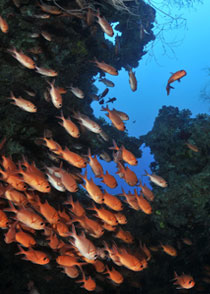 |
Absolute Scuba adds more to their already extensive list of choices here as more dive centers open doors to diving at various parts of these legendary islands. The Andamans are ideal for all levels of Diver.
Dive the Andaman Sea with both land-based & Liveaboard dive operators. Contact us for a get-away to Adventurous Andamans. |
|
|
Lakshadweep Islands are a National Treasure. And are guarded as a State Secret by most visitors, diver or not. The lack of bustle in these idyllic Atolls have maintained a charm that can only be described as “A step back in Time”.
Part of the same string of Islands as the Maldives, we tend to liken these islands to Text-Book diving experiences.
Brilliant blue water visibility leaves you wondering where the water is; coralline white sand beaches straight out of a movie and a sleepy, coconut tree-filled speck of island in the middle of dazzling aquamarine lagoons is what a Lakshadweep holiday entails.
Underwater, the Lakshadweep is Diver Heaven. In fact, the fish are curious about divers ! With only 5 of the 11 islands open to visitors, most islands do not have more than one dive operator.
With 10 solid years of diving experience in the Lakshadweep, Absolute Scuba takes you diving there with an insider’s know how. |
|
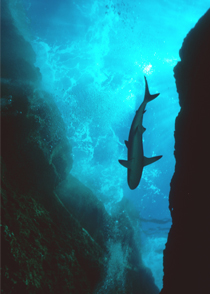 |
Rays, Reef Sharks, humongous amounts of Sea Turtles, shoals of over a 1000 species of reef Fish & residents everywhere, reef Walls&slopes from shallow depths to the Deep Blue make diving in the Lakshadweep a once in a lifetime experience.
The islands of Kadmat, Kavaratti, Kiltan, Agatti etc. make for some of the Best diving in India !
Contact us for typically-tropical holidays of a lifetime in Lakshadweep. Open for all levels. |
|
|
|
| |
This little archipelago in the Indian Ocean is home to several ecosystems, but most noted for the variety of colourful coral reefs; home to over 1100 species of fish, 5 species of sea turtles, 21 species of whales & dolphins and close to 180 species of coral.
Due to the dive sites being extensively dispersed, ‘live-aboard vessels’ are very popular - especially for trips to the remote and largely unexplored Baa Atoll. The local boats or "dhonis" with their distinctive high swung bows are popular for ferrying divers to and from sites over 'shorter' distances.
‘Land-based’ options at the Maldives spoil visitors for choice too. Home to some of the most exotic resorts in the world, Maldives has a plethora of amazing resorts with attached dive centers that promise you a holiday of a lifetime.
Open as a year round destination, February to April is the Island's peak diving period, with October and November signaling 'Manta season'. The monsoons usher in all sorts of incredible marine creatures with the tides.
Be sure to align your visit to maximize your Magical Maldives experience.
|
|
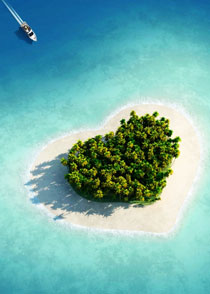 |
| |
|
|
|
To Greek cartographers, Sri Lanka was known as Taprobane. Arabs were inspired to refer to it as Serendib "serendipity" while the Portuguese favored Ceilao or Ceylon. The Sanskrit word, lamka, meaning 'resplendent land' has remained to this day, along with the favored term of endearment bestowed by the world; 'Pearl of the Indian Ocean'.
The island contains tropical forests, and diverse landscapes with high biodiversity. The country lays claim to a long and varying history of over three thousand years, having one of the longest documented histories in the world. Sri Lanka's rich culture can be attributed to the many different communities living on the island.
Sri Lanka's location in southwest of the Bay of Bengal and the Arabian Sea as well as its tropical climate and lush vegetation are a sure sign of the mirror image occurring below its waters.
Sri Lankan marine life is abundant and dives promise encounters with any one or more of the following: Groupers, Gray Sharks, Tuna, Angelfishes, Rays, Giant Maori Wrasses (Napoleons), Snappers, Pufferfish, Porcupinefish, sweetlips, trevally and breathtaking coral.
Easily accessible and a pot-pourri of diverse experiences, both in & out of the water, Sri Lanka is an essential destination on the diver’s “to-go” list. |
|
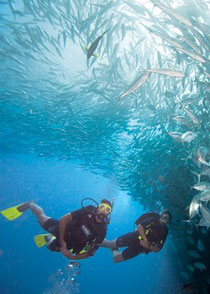 |
| |
|
|
|
Known as the “Soft Coral Capital of the World”, the Republic of Fiji is an island nation in the South Pacific Ocean about 1,100 nautical miles northeast of New Zealand's North Island.
The majority of Fiji's islands were formed through volcanic activity started around 150 million years ago. Today, some geothermal activity still occurs on the islands of Vanua Levu and Taveuni. Fiji has been inhabited since the second millennium BC. The country comprises an archipelago of more than 332 islands, of which 110 are permanently inhabited, and more than 500 islets.
Fiji has a significant amount of tourism and many people go to the Nadi and Denarau islands. Fiji has humongous amount of soft coral reefs, and scuba diving is a common tourist activity.More budget resorts are being opened in remote areas, which provides more tourism opportunities.
The climate in Fiji is tropical marine and warm most of the year round with minimal extremes. The warm season is from November till April and the cooler season May to October. Temperature in the cool season still averages 22 °C.
Much of the area's diving potential remains unexplored, however the Somosomo Strait, Taveuni, Kadavu and Bligh Water are becoming well known spots. |
|
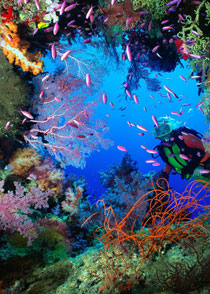 |
|
The Island's water visibility is best in winter and average diving depths reach around 40m. Pelagics, sharks, and various tropical fish play around the breathtaking coral reefs. Dolphins, Manta and Eagle rays, Turtles, Barracuda, Trevally, Cuttlefish, Surgeonfish, Fusiliers, Antheas and Flashlight fish abound.
With Fiji Tourism being actively promoted in India, this is a world class destination being brought closer home as we speak. And one that will blow your mind away with its text-book diving. |
|
Indonesia has about 300 ethnic groups, each with cultural identities developed over centuries, and influenced by Indian, Arabic, Chinese, and European origins.
You'll spend several lifetimes attempting to dive the entire Republic of Indonesia - that's if you can choose where to start among its 17,508 islands.
Indonesia's 80,000 kilometers (50,000 mi) of coastline are surrounded by tropical seas that contribute to the country's high level of biodiversity. Indonesia is one of the Coral Triangle countries with the world's greatest diversity of coral reef fish with more than 1,650 species in eastern Indonesia only.
Indonesia's lower water temperatures mean that it has delayed experiencing the destructive consequences of global warming. In addition, its prime geographical location that lends to a convergence of much of the worlds' marine species.
Anemone fish, angel fish, anthias, barracuda, batfish, bigeye, blanquillo, blue ringed octopus, blue spotted sting rays, bream, lionfish, bumphead parrot, butterfly fish, cardinal fish, catfish, clown fish, comet longfin, crocodile fish, damselfish and dolphin cover only the first quarter of the alphabet. Each other alphabet will in all likelihood find a corresponding resident in the Indonesian seas.
Temperatures range between 26 and 30 degrees in the warmer areas with good visibility on average, varying depending on the location. |
|
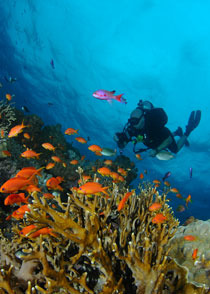 |
| |
|
|
|
Thai culture has been shaped by many influences, including Indian, Lao, Burmese, Cambodian, and Chinese. Derived the Thai word for 'freedom' and formally known as The Kingdom of Thailand and Siam, this exotic part of Southeast Asia is one of the world's better known island paradise dive destinations.
Since the 2004 Tsunami most of the affected areas have recovered well, such as the Similian Islands. Diving takes place all year round but the East coast's Andaman sea dive sites are the best around November to April. Water temperatures average 27 to 30 degrees with a visibility of 5 - 40m.
The Andaman Sea is regarded as Thailand's most precious natural resource ands it hosts the most popular and luxurious resorts in Asia. Statistics show that over 200,000 dive tourists visit Thailand a year. From 1999 to 2003 the Similans attained a fivefold increase in the number of visitors, which was just 10,000 and increased to 50,000; most of them divers.
Thailand boasts of an amazing array of diving destinations. To name a few: Phuket, Phi Phi andSimilan Islands, the Mu KohLanta National Marine Park and the National Marine Park at PhangNga Bay. |
|
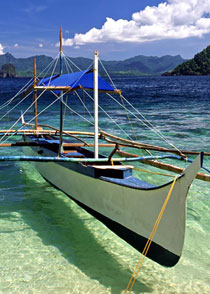 |
|
The islands of Krabi, KohSamui and Koh Tao along with the Ang Thong National Marine Park are some of the other hot spots of diving in Thailand. Koh Ha is known for its vast variety of coral species and Koh Si is great for snorkeling.
There are plenty of glassfish, gorgonians, sea fans, harbour pipefish, angelfish, green and hawksbill turtles, squid, black-tip reef sharks and leopard sharks to see. Other marine life around the islands include barracuda, sea horses, nudibranchs, scorpionfish, lobsters, large groupers and stingrays. |
|
The Red Sea is world renowned for the unparalleled quality of diving it offers.
Conditions in the Red Sea have created a one of a kind marine environment boasting a bio diversity that is superior tomost others in the world. Warm water, astounding visibility, dramatic drop offs and a vast array of 19th and 20th century wrecks just add to the appeal. Couple this with Egypt's fascinating history, friendly culture and sunny climate and it becomes evident why the Red Sea continues to be such a popular and well-loved destination.
The sea is the habitat of over 1,000 invertebrate species, and 200 soft and hard corals. More than 1200 species of fish have been recorded in the Red Sea, and around 10% of these are found nowhere else. This also includes 42 species of deep-water fish.
The rich diversity is in part due to the 2,000 kms of coral reef extending along its coastline. The reefs form platforms and sometimes lagoons along the coast and occasional other features such as cylinders (such as the Blue Hole at Dahab). These coastal reefs are also visited by pelagic species of red sea fish, including some of the 44 species of shark.
|
|
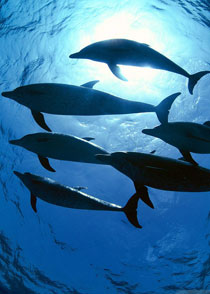 |
The Red Sea also contains many offshore reefs including several true atolls. Many of the unusual offshore reef formations defy classic (i.e., Darwinian) coral reef classification schemes.
The special biodiversity of the area is recognized by the Egyptian government, who set up the Ras Mohammed National Park in 1983. The rules and regulations governing this area protect local marine life, which has become a major draw for diving enthusiasts.
The sea is known for its spectacular recreational diving sites, such as Ras Mohammed, the wreck of SS Thistlegorm ,Elphinstone, The Brothers, Dolphin Reef and Rocky Island in Egypt.
Liveaboards are the ideal platform for the ideal dive holiday. First class diving combined with luxurious comfort, all served up in the relaxing atmosphere of the sun and the sea - what more can you ask for!
And it is never too early to get into the liveaboard swing of things. Irrespective of your experience level, we have a liveaboard to suit you.
See for yourself just why the Red Sea keeps people coming back for more year after year. |
|
|
|
|
 |
|
|
| |
|
|
|
|
|